 FM Stereo Tuner T-109V FM Stereo Tuner T-109V
|
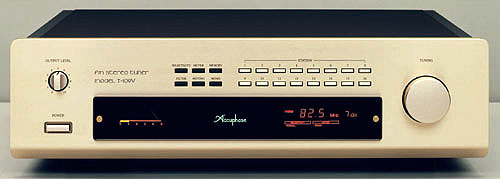
|
|
 Ultra-precise electronic tuning Ultra-precise electronic tuning |
 Front end with double-tuned antenna circut easily handles high signal
levels Front end with double-tuned antenna circut easily handles high signal
levels |
 High-performance adjustment-free Adevanced DGL Detector High-performance adjustment-free Adevanced DGL Detector |
 Extremely stable stereo decorder Extremely stable stereo decorder |
 32-station memory also stores reception settings 32-station memory also stores reception settings |
 Munual rotary knob with pulse tuning system Munual rotary knob with pulse tuning system |
 Blanced audio outputs Blanced audio outputs |
|
|
Rediscover the joy of music -- with this top-flight FM stereo tuner featuring
advanced RF technology. The front end can handle even extremely high input
signals, the Advanced DGL Detector assures top-quality reception performance,
and the stereo decoder employs a ceramic resonator for utmost stability.
Pulse tuning recreates the ease and feel of manual tuning in addition to
the convenient 32 station memory.
|
|
Among the great variety of program sources available today, such as CDs,
MDs, and DVDs, FM broadcasts still play a special role, since they cover
the entire spectrum from live performances of time-honored classical works
to the latest hits. The FM band provides a rich choice of music all day
long. The FM tuner therefore is an important component in a stereo system
designed to enlighten and entertain.
The FM Stereo Tuner T-109V from Accuphase was conceived for the music lover
who accepts no compromises when it comes to sound quality. It is based
on the highly renowned model T-109, providing even further refined sonic
characteristics and performance. Externally, the front panel has been redesigned
to match the styling of recent Accuphase components. The PLL electronic
tuning system pulls in any desired station with pin-point precision and
total reliability. A convenient memory function lets you store as many
as 32 stations including sensitivity and filter on/off settings, and the
pulse tuning principle developed by Accuphase blends digital accuracy with
the familiar feeling of operating an analog tuning knob. The front end
employs a dual-stage design that can handle even extremely high input signals
without cross modulation problems, and the Advanced DGL Detector assures
high performance and rock-stable reception. The stereo decoder takes sophisticated
circuit topology to new heights, with its reference frequency provided
by a ceramic resonator for utmost stability. To avoid diluting the outstanding
sonic virtues of this tuner further down the signal path, a balanced output
stage sends the audio signal to the next component without any sound quality
deterioration. A remote commander is also supplied, and the champagne gold
front panel blends perfectly with any listening room.
Ultra-precise electronic tuning
The T-109V tunes to the station frequency by means of a quartz crystal
oscillator that operates with extreme precision and is virtually free of
time or temperature induced drift. It precisely locks the tuner to the
reception point that yields minimum distortion and maximum sensitivity.
Electronic tuning also means that the T-109V is not susceptible to modulation
and other noise caused by external vibrations.
Front end with dual-stage demodulator handles high input signals easily
Each FM tuner has a front end that picks just the desired station out of
the crowded FM band and convert the radio frequency into an intermediate
frequency. The design of this stage is highly crucial, since it must discern
and select minute signals, while at the same time being able to withstand
the very high levels that can occur when a strong station is broadcasting
nearby. Freedom from interference and distortion is what makes the difference
between a run-of-the-mill product and a sophisticated high-class FM tuner.
Figure 1 shows the circuit diagram of the front end employed in the T-109V.
Accuphase has long been advocating the "double-tuned antenna circuit
principle", whereby a high selectivity circuit precedes the antenna
signal amplifier stage. This prevents intermodulation distortion and other
undesirable side effects which can occur if a strong signal is amplified
directly. The RF amplifier stage uses FET devices configured as a low-feedback
cascode amplifier. The input stage gate features a PIN-diode attenuator
that is switched on or off by a microprocessor, depending on the antenna
input level. This assures high-quality reception, free from interference
and distortion, even in areas close to strong broadcast stations that could
otherwise overload the front end.
|
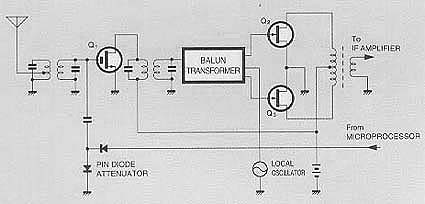
Figure 1 Circuit Diagram of Front-End
|
|
High-Performance Advanced DGL Detector
Accuphase originally developed the DGL (Differential Gain Linear) detector,
featuring low distortion, high S/N ratio, low capture ratio, and reliable,
adjustment-free performance. For the T-109V, Accuphase has further developed and refined the DGL principle, resulting in the Advanced DGL Detector.
Figure 2 (A) shows the circuit principle of the Advanced DGL Detector. The input stage uses a high-speed comparator as a broadband 2.4 MHz amplifier to prevent beat interference. The delay circuit consists of 24 high-speed C-MOS ICs.
|
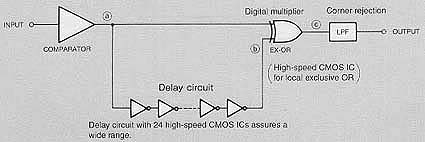
Figure 2(A)Princiople of DGL Detector
|
Figure 2 (B) illustrates the DGL operation principle. The delay circuit takes the slight output delay of high-speed logic ICs into consideration. An arrangement of 24 ICs delays the phase angle by 114 degrees to assure minimum distortion and maximum S/N ratio. The delayed signal (b) is then compared to the input signal (a) by an EXCLUSIVE OR circuit which switches the circuit on and off according to the electric potential between the two signals. The resulting density modulation is detected digitally (c) and extracted as the audio signal. Thanks to this approach, linearity of the delay circuit is maintained over a very wide range (+2.5 MHz -2.5MHz), and adjustment is not required, assuring excellent long-term reliability. Another advantage is outstanding differential gain linearity.
|
Switchable IF bandwidth (NORMAL, NARROW)
FM broadcasts have an audio frequency range of up to 15 kHz and S/N ratio
of about 80 dB. To make the most of this impressive quality potential,
the T-109V normally uses an IF stage with wide bandwidth (NORMAL) to receive
broadcasts. However, if there are strong neighboring stations which might
impair reception, the IF bandwidth can be switched to NARROW. In this position,
distortion and stereo separation are slightly worse, but selectivity is
maximized to ensure sharp reception.
Stereo decoder controlled by a solid resonator for ultra-low distortion
and excellent long-term stability
The right and left channel information of the FM stereo signal is encoded
by means of a 38-kHz subcarrier. To decode this information, the tuner
must produce a signal that is perfectly synchronized with the subcarrier,
allowing a switching circuit to extract the right and left signal components
at exactly the right time. Otherwise, stereo separation and imaging will
be notably impaired. To accomplish this task, the pilot signal in the input
is used to lock the oscillator of a PLL circuit in the tuner to the required
frequency, as shown in Figure 3 (A). In the T-109V, the internal PLL oscillator
employs a ceramic resonator, as shown in Figure 3 (B), in conjunction with
a reactance circuit that can be switched between positive and negative
reactance by a control voltage. This allows accurate switching in a narrower
locking frequency range than is possible with conventional circuits. The
circuit also assures superior long-term stability without the need for
adjustment.
|
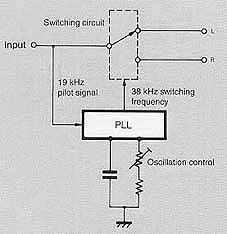
Figure 3(A)
Trimmer Type Stereo Demodurator |
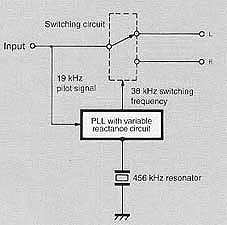
Figure 3(B)
Stereo Demodurator of T-109V |
Balanced audio output
The balanced signal transmission principle prevents sound quality deterioration
caused by externally induced noise. The T-109V offers a set of balanced
XLR connectors along with conventional RCA-type phono jacks.
|

Balanced audio output
|
|
32-station memory also stores reception settings
The T-109V allows the user to quickly store and recall up to 32 stations.
There are 16 station buttons which control two memory slots each. Selecting
the first or second station number of a button is easy: just keep the button
depressed for more than one second to select the second station number
(the station number flashes once). When storing a station, the T-109V memorizes
not only the broadcast frequency but also parameters such as filter and
selectivity settings. This lets you receive any station at the touch of
a button in optimum condition.
Innovative pulse tuning system developed by Accuphase allows manual tuning
with that traditional 'tuner feeling'
The T-109V not only offers the capability to instantly memorize and tune
in a station at the touch of a button, it also possesses a tuning knob
that makes it possible to hunt for broadcast stations with the familiar
feeling of an analog tuner. A disc with radial slits is mounted on a shaft
that is turned by the knob. Knob rotation is translated into a series of
pulses which are used by a microprocessor to control the PLL tuning frequency.
Low-level beep tones can be heard when the knob is turned, indicating the
frequency change.
Multi-function meter also indicates multipath
The meter of the T-109V can be switched to show either the antenna input
level (field strength) or multipath condition. Multipath distortion occurs
when the broadcast signal is reflected by buildings, mountains etc. and
arrives at the antenna in multiple instances (similar to ghost images on
a TV screen). To minimize multipath, it is essential to select the best
transmitter station and optimize antenna orientation, a task that is made
easy by the multipath indication mode of the meter on the T-109V.
Other features
The T-109V offers many other desirable features, including a switchable
Noise Filter that is useful to reduce noise on stereo broadcasts from weak
stations, a Muting Switch to eliminate noise during manual tuning, a Mono
Switch, and an Output Level Control that allows matching the tuner's output
level to that of other components in the system.
|
|
| T-109V Guaranteed specifications |
|
|
|
|
|
|
|